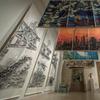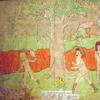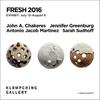'Hippie Modernism' Exhibition Comes to Berkeley, CA in 2017, Marking the 50th Anniversary of the Summer of Love
- BERKELEY, California
- /
- October 05, 2016
Exhibition Celebrates the 50th Anniversary of the Summer of Love by Showcasing Radical Art, Architecture, and Design of the Counterculture
Includes Dozens of Bay Area Works that Laid the Foundation for the Tech Revolution, the Environmental Movement, and Advances in Social Justice
The University of California, Berkeley Art Museum and Pacific Film Archive (BAMPFA) will launch the region-wide celebration of the 50th anniversary of the Summer of Love with Hippie Modernism: The Struggle for Utopia. This major exhibition examines the intersection of the radical art, architecture, and design of the counterculture of the 1960s and early 1970s and the resonance of these innovations today. A traveling exhibition organized by the Walker Art Center and assembled with the assistance of BAMPFA, Hippie Modernism will be on view in Berkeley from February 8 through May 21, 2017. The exhibition will coincide with the first anniversary of BAMPFA’s new Diller Scofidio + Renfro–designed building in downtown Berkeley.
Hippie Modernism charts the evolution of one of the most fertile periods of recent cultural history (c. 1964–74) with experimental furniture, alternative living structures, immersive environments, media installations, alternative magazines, experimental books, printed ephemera, and films. These works convey the social, cultural, and political ferment of the 1960s and 1970s, when radical experiments challenged convention, overturned traditional hierarchies, and advanced new communal ways of living and working. Hippie Modernism also demonstrates how the counterculture, once dismissed as a social and aesthetic anomaly, introduced ideas and techniques that have profoundly shaped contemporary life, including ecological awareness, social justice, and open communication. From yoga and organic foods to the Occupy Wall Street and Black Lives Matter movements, the counterculture’s legacy remains as strong as ever.
The curators of the Berkeley presentation, BAMPFA Director Lawrence Rinder and UC Berkeley Associate Professor of Architecture Greg Castillo, have expanded the scope of the exhibition to highlight the key role the Bay Area—and especially Berkeley—played in the counterculture movement. Many artists, architects, and designers in this period were searching for a new kind of utopia as an implicit critique of society; however, in the Bay Area, many hoped to go beyond mere critique to create actual change—technological, political, and ecological—on the streets, in the classroom, and in government policy. “Hippies were modern not because they believed that the world could be different than it was,” says Rinder, “but because they made that difference real.”
Archival materials from Bay Area protest movements and collectives—ranging from the Indians of All Tribes’ nineteenth-month-long occupation of Alcatraz (1969–71) to the radical performances of the Cockettes and the Angels of Light—represent the transformative activism of the period. Works by local artists and designers, including Frances Butler, J. B. Blunk, Sonya Rapoport, and Bonnie Ora Sherk, showcase the synthesis of High Modernism with counterculture style and themes, while images of the Emeryville mudflats anonymous sculpture park point to a radically individualist approach. Bay Area counterculture architecture is represented in the BAMPFA exhibition through documentation of the handbuilt houses in the towns of Canyon and Sausalito. Also new to the Berkeley display are posters from the Chicago Women’s Graphics Collective; the 1970 Gay-In in Griffith Park; and Gary D. Anderson’s original design for the now ubiquitous Recycle Symbol from 1970.
The Berkeley presentation will also include an in-depth, ten-week companion film series organized by Associate Film Curator Kate MacKay. The series includes documentaries, experimental works, and feature films that explore the progressive social, political, and aesthetic concerns of the era. Highlights include BAMPFA’s newly completed restoration of Steven Arnold’s Luminous Procuress; Haskell Wexler’s Medium Cool; Peter Watkins’s Punishment Park; and Michelangelo Antonioni’s Zabriskie Point. The series also includes a program of films from the Bay Area’s famed Canyon Cinema, which was founded as an artist co-op in the 1960s.
Central to the exhibition are works that attempt to expand individual consciousness through altered states of perception. Among these are the meditative films of Jordan Belson; the transcendental paintings of the USCO collective; Bruce Conner’s proto-music video, Breakaway; and conceptual work of radical architects and design groups such as Haus-Rucker-Co and Archigram.
A wide variety of images, books, magazines, posters, and prints reflect emerging social awareness and collective consciousness. Democratic modes of cultural production intended to forge networks of like-minded individuals, these works include Ken Isaac’s pioneering The Knowledge Box (1962/2009), a room-size chamber that immerses viewers in a montage of projected images culled from popular press; the posters designed by Emory Douglas for the Black Panthers newspaper; the silkscreened antiwar prints of Sister Corita Kent; and posters from the Berkeley People’s Park movement.
Other works address the rejection of conventional social structures and the dissolution of boundaries between art and life, culture and politics: Evelyn Roth’s living structures made from recycled sweaters; a re-creation of a dome by the Drop City collective, which housed their Ultimate Painting of 1968; and the performance activism of the Diggers, the Cockettes, and the Angels of Light.
Among other rarely seen highlights are the psychedelic paintings of Judith Williams and Isaac Abrams; documentation of utopian concepts and experiments such as Instant City in Spain, Superstudio in Italy, the Provo movement in Holland, and Ant Farm’s Truck Stop Network; experimental publications such as Scanlan’s, ONYX, and Free City News; and pioneering films, videos, and multimedia works by Bruce Conner, Jordan Belson, and the Boyle Family.






100x100_c.jpg)





![Peter Paul Rubens (Flemish, 1577–1640), After Titian (Tiziano Vecelli) (Italian [Venetian], c. 1488–1576), Rape of Europa, 1628–29. Oil on canvas, 71 7/8 x 79 3/8 in. Peter Paul Rubens (Flemish, 1577–1640), After Titian (Tiziano Vecelli) (Italian [Venetian], c. 1488–1576), Rape of Europa, 1628–29. Oil on canvas, 71 7/8 x 79 3/8 in.](/images/c/e2/2e/Jan20_Rape_of_Europa100x100_c.jpg)



